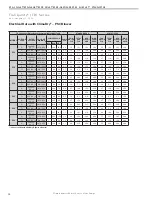
12
C L I M A T E M A S T E R W A T E R - S O U R C E H E A T P U M P S
Tr a n q u i l i t y
®
( T R ) S e r i e s
R e v. : N o v e m b e r 2 , 2 0 2 0
C l i m a t e M a s t e r Wa t e r - S o u r c e H e a t P u m p s
Vertical Installation
Flexible canvas duct
connector to reduce
noise and vibration
Use turning vanes in
supply transition
Internally insulate return
transition duct to reduce
noise
Rev.: 2/13
Internally insulate supply
duct for the first 4’ (1.2m)
each way to reduce noise
Rounded return
transition
Remove supply duct
flanges from inside blower
compartment and install
on supply air opening of
unit. Do not use a supply
air plenum/duct smaller
than the size of the supply
duct flanges.
Flexible canvas duct
connector to reduce
noise and vibration
Use turning vanes in
supply transition
Internally insulate supply
duct for first 1.2 m each way
to reduce noise
Internally insulate return
transition duct to reduce noise
Rounded return
transition
Remove supply duct
flanges from inside blower
compartment and install
on supply air opening of
unit. Do not use a supply
air plenum/duct smaller
than the size of the supply
duct flanges.
Figure 7: Vertical Unit Mounting
Figure 8: Typical Vertical Unit Installation Using
Ducted Return Air
bloque o del ladrillo o sacado
Cojín del aire o sacado
Bloque o ladrillo concreto
Air Pad or extruded
polystyrene insulation board
Vertical Unit Location -
Units are not designed for
outdoor installation. Locate the unit in an INDOOR area
that allows enough space for service personnel to perform
typical maintenance or repairs without removing unit from
the mechanical room/closet. Vertical units are typically
installed in a mechanical room or closet. Never install
units in areas subject to freezing or where humidity levels
could cause cabinet condensation (such as unconditioned
spaces subject to 100% outside air). Consideration
should be given to access for easy removal of the filter
and access panels. Provide sufficient room to make water,
electrical, and duct connection(s).
If the unit is located in a confined space, such as a closet,
provisions must be made for return air to freely enter the
space by means of a louvered door, etc. Any access panel
screws that would be difficult to remove after the unit is
installed should be removed prior to setting the unit. Refer
to Figures 7 and 8 for typical installation illustrations.
Refer to unit submittal data or engineering design guide
for dimensional data.
1. Install the unit on a piece of rubber, neoprene or other
mounting pad material for sound isolation. The pad
should be at least 3/8” [10 mm] to 1/2” [13 mm] in
thickness. Extend the pad beyond all four edges of
the unit.
2. Provide adequate clearance for filter replacement
and drain pan cleaning. Do not block filter access
with piping, conduit or other materials. Refer to
unit submittal data or engineering design guide for
dimensional data.
3. Provide access for fan and fan motor maintenance
and for servicing the compressor and coils without
removing the unit.
4. Provide an unobstructed path to the unit within the
closet or mechanical room. Space should be sufficient
to allow removal of the unit, if necessary.
5. Provide access to water valves and fittings and
screwdriver access to the unit side panels, discharge
collar and all electrical connections.
Vertical Unit Location
Notice!
Installation Note - Ducted Return: Many
horizontal WSHPs are installed in a return air ceiling
plenum application (above ceiling). Vertical WSHPs are
commonly installed in a mechanical room with free return
(e.g. louvered door). Therefore, filter rails are the industry
standard and are included on ClimateMaster commercial
heat pumps for the purposes of holding the filter only. For
ducted return applications, the filter rail must be removed
and replaced with a duct flange or filter frame. Canvas
or flexible connectors should also be used to minimize
vibration between the unit and ductwork.
Summary of Contents for Tranquility TR Series
Page 2: ......













































